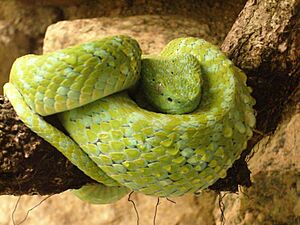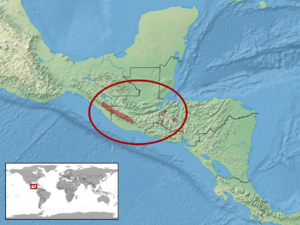Bothriechis bicolor facts for kids
Quick facts for kids Bothriechis bicolor |
|
|---|---|
 |
|
| Conservation status | |
| Scientific classification | |
| Genus: |
Bothriechis
|
| Species: |
bicolor
|
 |
|
The Guatemalan palm-pit viper, also known as the Guatemalan tree viper, is a venomous pit viper species. You can find this snake in southern Mexico, Guatemala, and Honduras. Its scientific name, Bothriechis bicolor, means "two colors," which describes its unique look. There are no different types (subspecies) of this snake known today.
What Does It Look Like?
Adult Guatemalan palm-pit vipers are usually about 60 to 70 centimeters (around 2 feet) long. Some can even grow up to 100 centimeters (over 3 feet)! They have a fairly thin body.
Their main color is green or bluish-green. Most of the time, they don't have any patterns. However, some snakes from Mexico might have small black spots or blue patches. The top of their head is a plain green, without any stripes behind their eyes. The skin between their scales is often blue, and sometimes the edges of their scales are blue too. Their belly is a bit lighter, usually a plain yellowish-green color.
Where Does It Live?
This snake lives along the Pacific side of Central America. You can find it from southeastern Chiapas in Mexico, stretching east into south-central Guatemala. It has also been seen in a few places in Honduras, specifically in the southern part of the Sierra del Merendón mountains and near Cerro Santa Bárbara. The first time this snake was officially described was from the forests of San Agustín in Guatemala.
Its Home Environment
The Guatemalan palm-pit viper loves to live in warm, wet places. It prefers rainforests and cloud forests. These snakes are found at elevations between 500 meters (about 1,640 feet) and 2,000 meters (about 6,560 feet) above sea level.
Is It Endangered?
Good news! The Guatemalan palm-pit viper is listed as "Least Concern" (LC) by the IUCN. This means it's not currently considered a threatened species. It has a wide distribution, and scientists believe there are many of them. Its population seems to be stable, meaning it's not decreasing quickly. This assessment was made in 2007.


